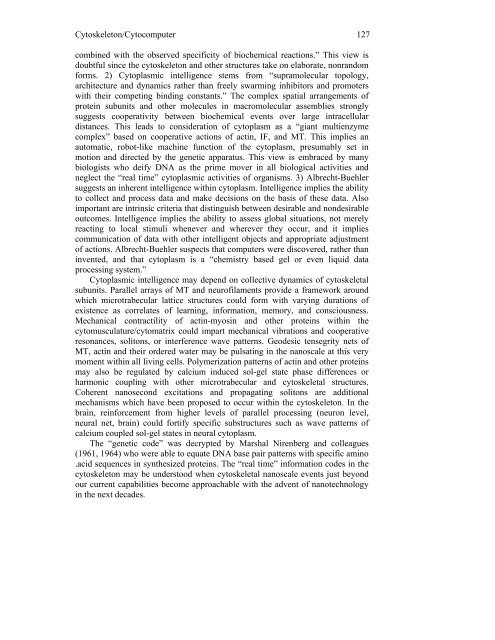ULTIMATE COMPUTING - Quantum Consciousness Studies
ULTIMATE COMPUTING - Quantum Consciousness Studies
ULTIMATE COMPUTING - Quantum Consciousness Studies
- No tags were found...
You also want an ePaper? Increase the reach of your titles
YUMPU automatically turns print PDFs into web optimized ePapers that Google loves.
Cytoskeleton/Cytocomputer 127<br />
combined with the observed specificity of biochemical reactions.” This view is<br />
doubtful since the cytoskeleton and other structures take on elaborate, nonrandom<br />
forms. 2) Cytoplasmic intelligence stems from “supramolecular topology,<br />
architecture and dynamics rather than freely swarming inhibitors and promoters<br />
with their competing binding constants.” The complex spatial arrangements of<br />
protein subunits and other molecules in macromolecular assemblies strongly<br />
suggests cooperativity between biochemical events over large intracellular<br />
distances. This leads to consideration of cytoplasm as a “giant multienzyme<br />
complex” based on cooperative actions of actin, IF, and MT. This implies an<br />
automatic, robot-like machine function of the cytoplasm, presumably set in<br />
motion and directed by the genetic apparatus. This view is embraced by many<br />
biologists who deify DNA as the prime mover in all biological activities and<br />
neglect the “real time” cytoplasmic activities of organisms. 3) Albrecht-Buehler<br />
suggests an inherent intelligence within cytoplasm. Intelligence implies the ability<br />
to collect and process data and make decisions on the basis of these data. Also<br />
important are intrinsic criteria that distinguish between desirable and nondesirable<br />
outcomes. Intelligence implies the ability to assess global situations, not merely<br />
reacting to local stimuli whenever and wherever they occur, and it implies<br />
communication of data with other intelligent objects and appropriate adjustment<br />
of actions. Albrecht-Buehler suspects that computers were discovered, rather than<br />
invented, and that cytoplasm is a “chemistry based gel or even liquid data<br />
processing system.”<br />
Cytoplasmic intelligence may depend on collective dynamics of cytoskeletal<br />
subunits. Parallel arrays of MT and neurofilaments provide a framework around<br />
which microtrabecular lattice structures could form with varying durations of<br />
existence as correlates of learning, information, memory, and consciousness.<br />
Mechanical contractility of actin-myosin and other proteins within the<br />
cytomusculature/cytomatrix could impart mechanical vibrations and cooperative<br />
resonances, solitons, or interference wave patterns. Geodesic tensegrity nets of<br />
MT, actin and their ordered water may be pulsating in the nanoscale at this very<br />
moment within all living cells. Polymerization patterns of actin and other proteins<br />
may also be regulated by calcium induced sol-gel state phase differences or<br />
harmonic coupling with other microtrabecular and cytoskeletal structures.<br />
Coherent nanosecond excitations and propagating solitons are additional<br />
mechanisms which have been proposed to occur within the cytoskeleton. In the<br />
brain, reinforcement from higher levels of parallel processing (neuron level,<br />
neural net, brain) could fortify specific substructures such as wave patterns of<br />
calcium coupled sol-gel states in neural cytoplasm.<br />
The “genetic code” was decrypted by Marshal Nirenberg and colleagues<br />
(1961, 1964) who were able to equate DNA base pair patterns with specific amino<br />
.acid sequences in synthesized proteins. The “real time” information codes in the<br />
cytoskeleton may be understood when cytoskeletal nanoscale events just beyond<br />
our current capabilities become approachable with the advent of nanotechnology<br />
in the next decades.






